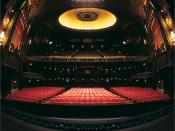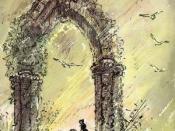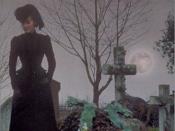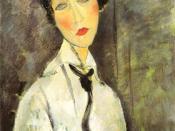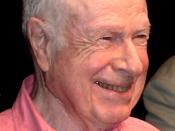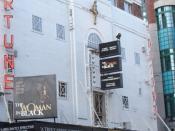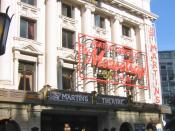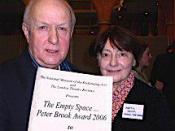Claire Hudson 9904339 December 2001 Theatre Visit Essay Is this theatre event an example of holy theatre, rough theatre, immediate theatre or deadly theatre according to the use of these terms in Peter Brooks book "The Empty Space"? The event may be a mixture of the above.
Justify your answer with reference to what is communicated by this event, how it is communicated and the effectiveness of the communication.
In this essay I will be discussing the Play "The Woman in Black" in relation to Peter Brooks "The Empty Space". This essay will argue that The Woman in Black is a form of Holy theatre with hints of the deadly and the rough theatre.
The Woman in Black is a play adapted from the book of the same name by Susan Hill. The interesting approach the play has, is that it looks incredible simplistic, for instance the set is an old theatre stage with a hamper a table and two old chairs as the only props.
There are only two actors (excluding the ghost) who play seven parts between them both. I found this at first surprising, as The Woman in black is a story that takes place in many big, very grand and ornate locations a huge manor house wide moors and a never ending foggy sea. We don't see that the stage is cleverly split into two parts- front stage where the first part of the action is performed and behind a huge screen is another part of the stage where a lot of the effects are created giving the audience the feeling that they are in different parts of the country and of Eel marsh House. It is the sound and lighting design that brings the audiences imagination alive, sound is used to shock the audience making the hairs on the back of their neck stand up and with the combination of excellent lighting design we have no problem suspending our disbelief. In "The Theory of Modern Stage" Eric Bentley states: "Light can play as directly upon our emotions as music does. We are more immediately affected by our sensitiveness to variations of light in theatre than we are by our sensations of colour, shape or sound." The audience is taken in and out of the story, which is being acted out by the theatre director and the solicitor "Arthur Kipps". There are two stories happening simultaneously one of the troubled solicitor and the woman in black and the story of them acting the story out. The story is brought to our attention with recorded sound design when the hamper is turned into a pony and trap we hear the sounds of the pony whinnying and the clip-clop of the hooves.
The woman in black is a long running west-end play that has had a lot of commercial success. As it is a horror story and its popularity is partly in its shock value and sensationalistic reviews I think it can fit into what Peter Brook calls Deadly Theatre but it is not "bad" theatre. For me it was an excellent 2hrs entertainment, I wasn't bored at any point I didn't have to pretend to be interested in it. I think this play can fit in to a form of Holy theatre due to it's way of sound and light craft that makes the invisible visible and gave me a feeling of wonder and awe, of what theatre should be traditionally and it did not disappoint.
The story is communicated is a number of very effected ways. At the opening Arthur Kipps is starting his story and the director is sitting in the audience so we feel we are part of the play in the space of the action. We are in the theatre in the play which make us feel that is more encapsulating as we are almost in the story but we are invisible to the characters, we are almost like ghosts ourselves. The use of the theatre's space is paramount to discussing the communicative effect of this production. The whole stage is used to maximum effect and with shaped light filter to illustrate that we are out side of a mansion then the same screen is used as a staircase, a graveyard and a nursery. This use of space almost goes into the aisle, front row and down the side stage stairs. This use of space is at first feels quite unusual but it makes the audience feel more connected with the action and the characters. We are watching a re-enactment of events that have happened in the solicitor's life, we are watching spoken live action with many parts of it being narrated. The play uses ancient Greek story telling techniques like the Homeric ones of taking us out of the action as Homer often used in Flash backs to ease the tension to extend and heighten the drama when we return to it. This play does just this when a scene is finished or one of the characters doesn't like a part of the scene we are taken back to the present this gives us a sense of relief and time to evaluate what has just happened.
Peter Brook describes Deadly Theatre as becoming the norm in culture because the world has changed so much and theatre is still trying to mimic "The way it was written" Brook sees this as being impossible as we don't have the same mannerisms or expressions that a lot of plays were written for and as Brook says this turns the actors in to Hams. Directors and actors are creating something without "artistic values". The economics of theatre producing are also creating a deadly form of theatre as there isn't the time to rehearse or for the actor to find the true essence of their characters. I am torn between thinking that The Woman in Black is in some parts what Peter Brook would call Deadly Theatre as some people have criticised the play for being farcical and a low budget comedy and a routine ghost story. I think from what I have discovered of Deadly theatre and what I think it is The Woman In Black could be called deadly by many critics because it is such a commercial success, in the west end and has been running for over ten years. I, myself would argue against this I would say that this play is an example of theatre with substance, artistic value and durability, people who call it a "Routine ghost story" have missed the point of how effective our imaginations can be especially with ghost stories.
Peter Brooks' term "Rough theatre" comes into "The Woman in Black" slightly because the stage is sparse and special lighting and effects kept minimal. The play communicates an intensity that is very real through this simplistic style; it is almost touchable and this in turn creates a tension that is at times overwhelming. Rough Theatre is "the theatre of the people" the idea that theatre can be anywhere as long as there are performers and an audience anywhere can build an "explosion of life" (pg.65). I don't think that The Woman in Black is rough theatre but it is mimicking the idea of the simplicity of rough theatre to draw us closer into the action. We feel like we are in the story because of the theatre design, we are also watching their idea take shape and grow, the performance of the solicitors' story takes on a life of it's own and he almost becomes unstoppable.
Returning to the idea of Holy Theatre, this term gives us strong ideas of the Christian art and form taking a traditional moral angle. Brook describes Holy theatre "Many people believe that in the recent past there still was a theatre of certain values, certain skills, certain arts that we perhaps have destroyed or cast aside" (pg. 44). This suggests that we have lost something in modern theatre, that nostalgia cannot bring back to life the essence of wonder that we had when we were children. He also criticises how people have "lost all sense of ritual and ceremony" (pg.45). We spend too much time and money on new specially designed new theatres theatre cannot be built like they used to be because the "ceremony" (pg.45) has changed and these changes have not coincided with each other. I feel that The Woman in Black does give a sense of ritual and ceremony that fits into our ideas of what theatre should do for us. The Fortune Theatre is a good example of a theatre that can do a play like The Woman in Black justice. It is quite a small, intimate theatre very old and worn with very squeaky seats. This is a perfect example of what Peter Brooks is talking about in the use of his term Holy theatre; the play fits its surroundings.
Holy theatre replaces a need for something that isn't there in peoples' everyday lives it is an escape from reality and a taking part in a ceremony the moment they step in the door of the theatre.
"The true dream of the debased ideals of the deadly theatre" (pg.42) The holy theatre is what we all go to the theatre for but usually end up experiencing deadly theatre and being disappointed so the public don't take the chances of buying a ticket because they are so used to being let down. The invisible can appear in holy theatre because everything is right, the stage, the actors, the lighting, the music and the costumes everything comes together and we suspend our disbelief and anything is possible. The Woman in Black does all of these things for me; I haven't been to a theatre event that has made me react so physically since seeing Pantomime as a child. It was able to have such a strong effect on the audience that I think it is an enormous achievement. To make the audience jump, scream and shudder (without any hint of farce in my opinion) and not to cop out and conform to the audiences wishes to have a happy ending, is a theatre that we are all longing for and according to Peter Brook it can only be a Holy one.
I feel I have to make some criticisms of Peter Brooks' terms, to acknowledge what counts as deadly theatre I think you would have to be quite a seasoned theatre goer to notice the faults in mannerism or behaviour, also if it is "commercial" theatre that is so bad, then why is it popular? I think Brook is suggesting some kind of elitist verses popularist argument that the general cannot tell between good theatre and bad theatre.
